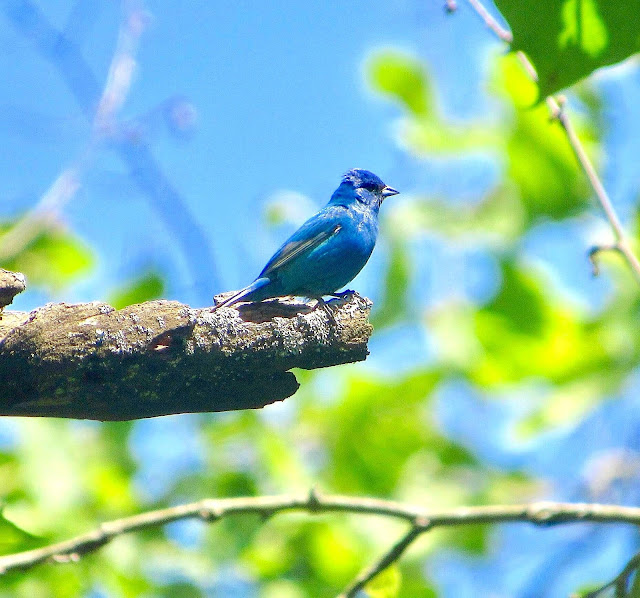To beat the summer heat birders should learn the songs
Summer heat, heavy foliage adds to birding difficulty; knowing the songs helps
Contrary to a widespread
misconception, the summer months are NOT the best time for birding in
Northeast Ohio.
Which
is not to say there aren’t plenty of desirable species to see
during the hot and humid span of late June, July and August. The
conditions just require birders to make a few adjustments in their
approach, and to work a little harder to locate and spot the birds.
 |
| Orchard oriole, female/Karen Lakus |
Fortunately,
the majority of summer birds are in the process of finding mates,
defending territory, nesting and raising young, which inspires the
males to sing. So it helps to know your songs.
Summer
trees and shrubs are lush with foliage, providing sources of food and
cover for the birds, but making sightings especially difficult for
birders. Knowing the songs is beneficial in this pursuit.
All
of these factors came into play during a few recent bird walks
through some of the best local habitats. At each of the sites, the
only realistic opportunities to see the most popular target birds was
to hear them first.
At
the Station Road trailhead in the Cuyahoga Valley National Park,
Karen Lakus and I patiently searched the canopies of towering
sycamores from where we heard the songs of two reliable nesters, the
yellow-throated and cerulean warblers. We succeeded in locking these
tiny songbirds in our binoculars, but likely would have failed
without first identifying their songs.
 |
| Bald eagles/Karen Lakus |
A
third common nester, the indigo bunting, posed less of a challenge.
We heard and saw more than a dozen, including one brilliant blue male
at eye level. Typically, the buntings are adept at singing while
remaining hidden in lush canopy foliage. Veteran
birders describe the song as “What,
what! Where, where?
See it, see it!”
We
were less fortunate in our attempts to glass a singing prothonotary
warbler, a golden resident of the Pinery Narrows swamp, where access
has been shut off in deference to the bald eagles nesting there. But
we were lucky to be watching the nest from across the Cuyahoga River
when one of the adult eagles arrived at the nest with a fish, which
the two fledglings immediately devoured.
Other
sightings in the park included white-eyed, red-eyed and warbling
vireos, great crested and Acadian flycatchers, Easter wood-pewee,
blue-gray gnatcatchers, wood thrush, and common yellowthroats –
most with the aid of hearing them first.
An
exception to the rule was a female orchard oriole that posed atop a
small tree gleaning insects from the newly emerged leaves without
making a sound.
 |
| Snapping turtle/Karen Lakus |
Later
in the week, I joined Cleveland Metroparks naturalist Jake Kudrna
on a group bird walk at the Cleveland Lakefront Nature Preserve, an
88-acre manmade haven that hosts dozens of nesting yellow warblers.
Baltimore
orioles are also common there, and we spotted a pair of orchard
orioles. Other finds included willow flycatchers, best distinguished
from the similar Acadian flycatcher by its song. Willows
sound like “fitz-pew!”
Acadians like
“peet-sa!”
On
a solo walk at the Bath Nature Preserve, a broad expanse of grass
there provided close encounters with nesting bobolinks and Henslow’s
sparrows, an uncommon prairie
species usually located
by its song, often described as a weak hiccup, “tsleep.”
The
scarlet tanagers in the woodlands produce a song sometimes described
as sounding like a hoarse
robin. Rose-breasted
grosbeaks, on the other hand, have a sweeter song similar to a robin
that has taken singing lessons.
 |
| Widow skimmer dragonfly/Karen Lakus |
A
small bird flitting among the lower branches skirting a swamp was
singing a mnemonic
similar to “please, please, please
to meetcha!” It was a chestnut-sided warbler, an unexpected
surprise in Northeast Ohio during the summer.
A
pair of trumpeter swans are causing excitement at the wetlands, where
they are raising two cignets.
Later
next month, birders will encounter new challenges in Northeast Ohio
as the first wave of migrating shorebirds arrive from their Arctic
nesting grounds while on their journey to South America. Shorebirds
seldom sing, but they pose new problems for birders attempting to
figure out their similar plumages. We’ll save that season for a
later column.




Good stuff!!
ReplyDelete